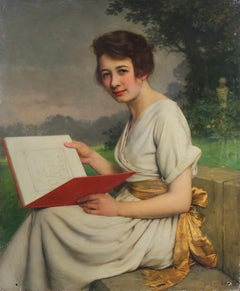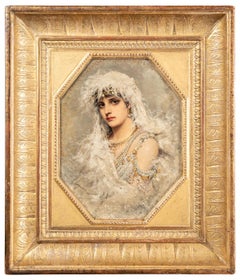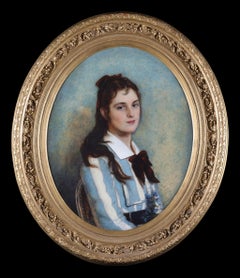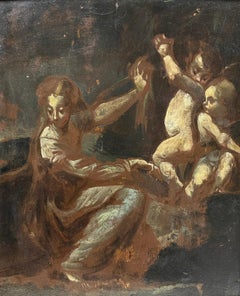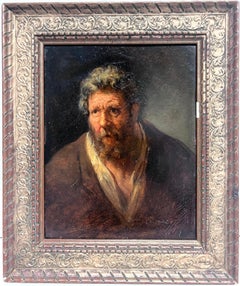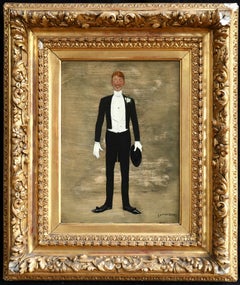Jan Van Beers Portrait Paintings
Belgian, 1852-1927
Jan van Beers is a Belgian artist and son of the poet, Jan van Beers. He studied at Aversa and then moved to Paris, where he worked for Alfred Stevens. He made a lot of illustrations for a lot of magazines, such as Revue illustrée.
to
1
1
1
Overall Width
to
Overall Height
to
2
1
1
1
3
3
3
2
2
1
1
1
3
3
1
1
4
252
91
81
74
2
3
Artist: Jan Van Beers
Portrait of a woman in a garden oil painting on panel by Jan Van Beers
By Jan Van Beers
Located in Gavere, BE
Info artist :
Van Beers studied at the Academy in Antwerp. In 1873, he undertook a trip to London with Alexandre Struys. In 1878, Van Beers went to Paris where he worked in the stud...
Category
Early 1900s Victorian Jan Van Beers Portrait Paintings
Materials
Oil, Wood Panel
Fleur de Neige, Portrait de Mme Godillot
By Jan Van Beers
Located in Saint-Ouen-sur-Seine, FR
Fleur de Neige by Jan Van Beers, painted in July 1880, stands out for the delicacy of its depiction. This remarkable portrait depicts a woman dressed in a sumptuous white costume, ad...
Category
1880s Old Masters Jan Van Beers Portrait Paintings
Materials
Oil
The Beautiful Maiden
By Jan Van Beers
Located in St. Albans, GB
Jean Marie Constantin Joseph (Jan) VAN BEERS
Oil on Panel
Panel Size: 32 x 24" (81 x 62cm)
Outside frame Size: 38 x 33" (97 x 83cm)
Van Beers (1852 ...
Category
1870s French School Jan Van Beers Portrait Paintings
Materials
Oil
Related Items
Angelic Cherubs with Classical Figure in Wilderness Finely Painted Preparatory
Located in Cirencester, Gloucestershire
Figure with Cherubim in Wilderness
Italian School, 17th century
oil painting on wood panel
framed 13 x 11 inches
condition: overall for its age very good, though the work is most likely a preparatory...
Category
17th Century Old Masters Jan Van Beers Portrait Paintings
Materials
Oil, Wood Panel
$3,570
H 13 in W 11 in D 1 in
Early 1800's Italian Oil Painting Portrait of Bearded Man Saint Peter Apostle
Located in Cirencester, Gloucestershire
Italian School, early 19th century
'Portrait of a Bearded Man' - possibly Saint Peter?
oil on board, framed
framed: 16 x 13.5 inches
board: 12.5 x 9.5 inches
provenance: private col...
Category
Early 19th Century Old Masters Jan Van Beers Portrait Paintings
Materials
Oil
Portrait of a French 19th century lady in a gilt and ormolu hand made frame
By Gustave Jean Jacquet
Located in Woodbury, CT
Gustave Jaquet
Jacquet was born on 25th May 1846 in Paris. He was a pupil of Bouguereau and for his debut at the Paris Salon in 1865, he exhibited 'The Reverie' which was very much i...
Category
1860s Victorian Jan Van Beers Portrait Paintings
Materials
Oil, Wood Panel
$5,160 Sale Price
20% Off
H 14 in W 12 in
18th Century Venetian School Portrait of a Bishop Oil on Panel Green Brown Black
Located in Sanremo, IT
Painting oil on panel measuring 40 x 30 cm without frame and 48 x 38 with frame representing a great bishop of the Venetian school from the first half of the 18th century.
Very curi...
Category
Early 18th Century Italian School Jan Van Beers Portrait Paintings
Materials
Oil, Wood Panel
$1,150 Sale Price
20% Off
H 15.75 in W 11.82 in D 1.19 in
Portrait of a Mary Hardy (nee Sulman), Late 19th Century Victorian Oil
Located in London, GB
Slade School
Late 19th Century
Portrait of a Mary Hardy (nee Sulman)
Oil on panel
Image size: 8 x 7 inches
Contemporary frame
Provenance
Lady Town (Grandda...
Category
Late 19th Century Victorian Jan Van Beers Portrait Paintings
Materials
Oil, Panel
Mid 19th Century French Provincial Oil Portrait of Lady & Her Dog, framed
Located in Cirencester, Gloucestershire
Portrait of a Lady with her Pet Dog
French School, mid 19th century
oil on canvas, framed
framed: 36 x 28 inches
canvas: 29 x 20 inches
Provenance: private collection, France
Conditi...
Category
Mid-19th Century French School Jan Van Beers Portrait Paintings
Materials
Oil, Canvas
Portrait of Lady Caroline Price
By George Romney
Located in Miami, FL
DESCRIPTION: Perhaps the best Romney in private hands. If Vogue Magazine existed in the late 18th century, this image of Lady Caroline Price would be ...
Category
1970s Old Masters Jan Van Beers Portrait Paintings
Materials
Oil, Canvas
Fine Antique Classical Nude Draped in Robes Dancing with Dog Gold Background
Located in Cirencester, Gloucestershire
Artist/ School: Italian School, 19th century
Title: Classical nude draped in robes with dancing dog. The work looks as though it might have been a ceiling...
Category
19th Century Old Masters Jan Van Beers Portrait Paintings
Materials
Oil, Canvas
1850's Large Mid 19th Century French Portrait of a Young Gentleman Signed Oil
Located in Cirencester, Gloucestershire
The French Gentleman
by Paul Goubil (French mid 19th century)
signed and dated 1855
oil on canvas, framed
framed: 30.5 x 25 inches
canvas: 29 x 24 inches
Provenance: private collecti...
Category
Mid-19th Century French School Jan Van Beers Portrait Paintings
Materials
Oil, Canvas
Fine 18th Century British Old Master Oil The Young Shepherdess with Lamb
Located in Cirencester, Gloucestershire
The Young Shepherd
English School, 18th century
circle of Sir Joshua Reynolds
oil on canvas, unframed
Canvas: 30 x 25 inches
Provenance: Private collection
Condition: very good condi...
Category
18th Century Old Masters Jan Van Beers Portrait Paintings
Materials
Oil
Fine Quality 17th Century Dutch Old Master Oil on Wood Panel Trial of Christ
Located in Cirencester, Gloucestershire
The Trial of Christ
Dutch Old Master, 17th century
oil on panel, unframed
panel: 11 x 7.5 inches
provenance: private collection, England,
Christies auction stencil marks verso
condi...
Category
17th Century Baroque Jan Van Beers Portrait Paintings
Materials
Oil, Wood Panel
Portrait of a Gentleman, Doublet & White Ruff, Gloves Inscribed 1624, on panel
By Frans Pourbus the Younger
Located in London, GB
Titan Fine Art presents this exquisite oil on panel portrait depicting a handsome young gentleman in an exuberant black damask doublet. The pose, with one hand holding gloves and the other akimbo, was one that was well-established for gentleman of the upper echelons of society by the time this work was painted. The principle governing portraits at this time was the recording and defining in visual terms of the position of a sitter in society. In addition to brilliant and complex symbols of luxury, they often contained many symbolic elements too; the inclusion of gloves was often used in portraits that celebrated a betrothal as in ancient times gloves were used to seal a marriage contract.
The extraordinary costume of a black shimmering doublet, the brilliant white reticella ruff, and the cuffs edged with lace were immensely costly… this attire proclaims to every onlooker that this is a superior being. The rendering of the reticella lace ruff is exquisite and the artist has recorded the design that runs through the black damask fabric with meticulous attention to detail. The preservation of this black pigment is remarkable considering the age of the work. Black pigments are especially vulnerable to fade and wear over time partly due to environmental condition but also from unprofessional cleaning. This work is an exquisite example from the period.
According to the inscription in the upper right, the gentleman was in his 22nd year of age in 1624. The coat of arms, which is displayed without a crest, may be ‘blazoned’ in the language of heraldry, as: Sable on a Chevron between in chief two Roundels and in base a Billet [or possibly Square] Or three Martlets Sable. In plainer English this means a black (Sable) background, spanned by a gold (Or) chevron, above which are two golden solid circles (Roundels), and below which is a gold rectangle (Billet); on the chevron are three small black birds (Martlets). Martlets are a stylised form of heraldic bird, believed to be based on the swift, which are conventionally drawn with small tufts instead of feet. In Continental Europe it is also conventional for them to be drawn without beaks, as appears to be the case here. The birds in this instance also have a vaguely duck-like appearance.
Five families have been identified with very close armorial bearings to the one in our portrait. They are the (van) Houthem’s (of Brabant), the Prévinaire’s (of Flanders and Holland), and the Proveneer’s (of Liège) and it must be noted that the locations of these families also fit with the painting’s Flemish origins. However the French Grenières’s (of Île-de-France) and the Jallot’s (of Normandy) are the next closest matches and plausible matches, as Frans Pourbus had settled in Paris just a few years before our portrait was painted.
This painting has been assessed by a professional conservator prior to going on sale, and as thus, it can be hung and enjoyed immediately.
Frans Pourbus the Younger...
Category
17th Century Old Masters Jan Van Beers Portrait Paintings
Materials
Oil, Wood Panel
$18,331
H 42.13 in W 31.11 in D 3.94 in
Previously Available Items
Celebration - 19th Century Oil, Portrait of Elegant Gentleman by Jan Van Beers
By Jan Van Beers
Located in Marlow, Buckinghamshire
Oil on panel by Belgian painter Jan Van Beers depicting a smiling, elegant gentleman wearing a tuxedo with tails, wearing a monocle and holding a hat...
Category
Early 1900s Impressionist Jan Van Beers Portrait Paintings
Materials
Oil, Panel
The Serenade
By Jan Van Beers
Located in Marlow, Buckinghamshire
A lovely turn of the century depiction of a young man holding a rose in front of a sleeping girl. Beautifully painted oil on panel. Signed lower right. c.1900.
Beers began his artis...
Category
Early 1900s Impressionist Jan Van Beers Portrait Paintings
Materials
Oil, Panel
Jan Van Beers portrait paintings for sale on 1stDibs.
Find a wide variety of authentic Jan Van Beers portrait paintings available for sale on 1stDibs. You can also browse by medium to find art by Jan Van Beers in oil paint, paint and more. Not every interior allows for large Jan Van Beers portrait paintings, so small editions measuring 33 inches across are available. Customers who are interested in this artist might also find the work of and Angelo Granati. Jan Van Beers portrait paintings prices can differ depending upon medium, time period and other attributes. On 1stDibs, the price for these items starts at $13,532 and tops out at $13,532, while the average work can sell for $13,532.
Artists Similar to Jan Van Beers
Questions About Jan Van Beers Portrait Paintings
- 1stDibs ExpertFebruary 7, 2024Jan van Eyck was important to the Renaissance because he set new standards for the techniques employed by Northern European artists due to his incredible skill. While Italian Renaissance artists focused on capturing perspective and emotional expressiveness, the Flemish painter was more interested in showing things in exacting detail, so they looked as real as possible. His achievements in this detail and in conveying the differences between light and shadow would influence many other painters. On 1stDibs, find a wide range of fine art.
